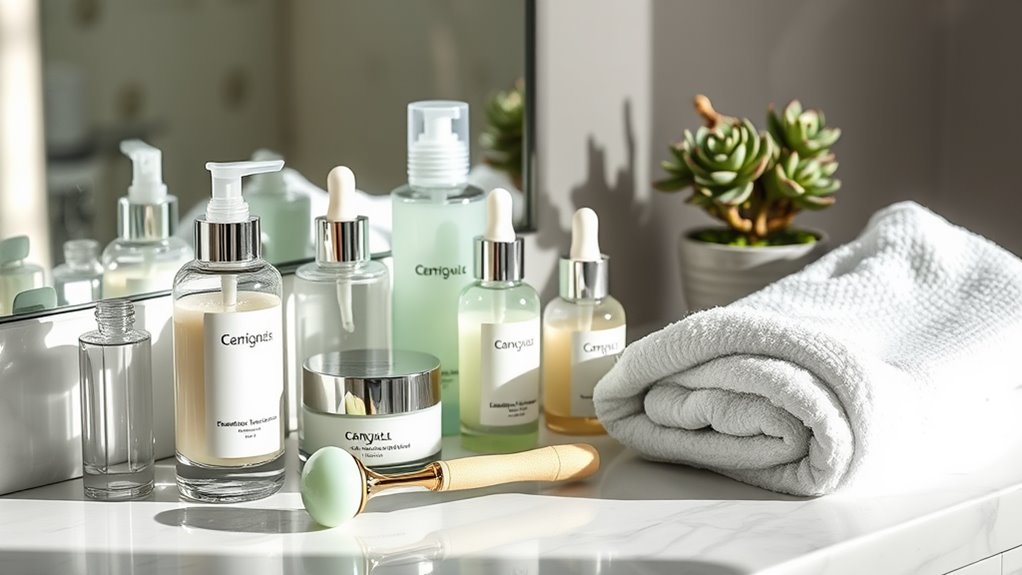How to Build the Perfect Skincare Routine for Any Skin Type
To build the perfect skincare routine, start by identifying your skin type—be it oily, dry, combination, sensitive, or normal. Next, incorporate essential steps: cleanse to remove impurities, exfoliate to slough off dead cells, moisturize to maintain hydration, and apply broad-spectrum SPF for sun protection. Adjust your routine seasonally, using richer products in winter and lighter ones in summer. Following these guidelines can greatly improve your skin’s health; there’s more insight to uncover.
Understanding Your Skin Type
How well do you know your skin type?
Identifying your skin type—oily, dry, combination, or sensitive—is essential for a custom skincare routine.
Each type has distinct characteristics: oily skin often appears shiny and prone to acne, while dry skin feels tight or flaky.
Combination skin displays both oily and dry areas, and sensitive skin reacts easily to products.
Understanding these traits allows you to select products tailored to your needs, ensuring ideal results.
Research indicates that using the right formulations can enhance skin health and appearance, making it essential to assess your skin type before creating your personalized regimen. To determine your skin type accurately, consider conducting a simple at-home test that reveals your skin type and provides further insights into your skincare needs.
Essential Steps in a Skincare Routine
A well-structured skincare routine consists of several essential steps that work together to promote healthy skin. To guarantee effectiveness, follow these stages consistently:
| Step | Purpose |
|---|---|
| Cleansing | Removes impurities and excess oil |
| Exfoliation | Sloughs off dead skin cells |
| Toning | Balances skin’s pH levels |
| Treatment | Addresses specific concerns |
| Moisturizing | Hydrates and protects skin |
Incorporating these steps tailored to your skin type can enhance overall skin health. Consistency is key; your skin will thrive with a dedicated approach to these essential elements. Additionally, integrating specific routine elements can drastically improve your skincare results.
Cleansing: The Foundation of Skincare
Cleansing is vital for maintaining healthy skin, as it removes dirt, oil, and impurities that can cause breakouts and irritation. Choosing the right cleanser tailored to your skin type can enhance this essential step, ensuring your skin stays balanced and refreshed. According to expert dermatologists, optimal face-washing frequency is key to achieving the best results for your skin.
Importance of Cleansing
Why is cleansing often regarded as the foundation of any effective skincare routine?
Cleansing removes dirt, oil, and impurities that accumulate throughout the day, preventing clogged pores and breakouts.
Research shows that proper cleansing enhances the efficacy of subsequent skincare products, allowing active ingredients to penetrate better.
It also helps maintain skin’s natural barrier, reducing the risk of irritation and inflammation.
By establishing a consistent cleansing routine, you promote a healthier complexion and create a clean canvas for hydration and treatment.
Ultimately, effective cleansing is crucial for achieving and maintaining ideal skin health, making it an essential first step in your regimen.
Choosing the Right Cleanser
How do you determine the best cleanser for your skin type?
Selecting the right cleanser is essential for maintaining skin health.
Here are three key factors to evaluate:
-
Skin Type: Identify if your skin is oily, dry, combination, or sensitive. Gel cleansers suit oily skin, while cream-based options work best for dry skin.
-
Ingredients: Look for specific ingredients; salicylic acid helps with acne, while hyaluronic acid hydrates.
-
pH Balance: Opt for a cleanser with a pH close to your skin’s natural level (around 5.5) to avoid disrupting the skin barrier.
Choose wisely to enhance your skincare routine.
Exfoliation: Removing Dead Skin Cells
Exfoliation is essential for maintaining healthy skin, as it removes dead skin cells that can lead to clogged pores and dullness. You can choose from physical or chemical exfoliators, each with different benefits and applications. Understanding how often to exfoliate based on your skin type will help you achieve best results and enhance your overall skincare routine. Additionally, selecting the right type of exfoliator for your skin type is crucial to avoid irritation and maximize effectiveness.
Importance of Exfoliation
Have you ever wondered why your skin appears dull or uneven?
Exfoliation is essential for maintaining healthy skin by removing dead skin cells that can clog pores and hinder cell renewal.
Here’s why you should prioritize it:
- Enhances Radiance: By sloughing off dead cells, exfoliation reveals fresh, glowing skin underneath.
- Improves Absorption: Proper exfoliation allows your skincare products to penetrate deeper and work more effectively.
- Prevents Breakouts: Regular exfoliation helps prevent clogged pores, reducing the likelihood of acne formation.
Incorporate exfoliation into your routine for smoother, healthier skin and to reveal your complexion’s full potential.
Types of Exfoliators
Understanding the different types of exfoliators can help you choose the right one for your skin type and concerns.
There are two main categories: physical and chemical exfoliators.
Physical exfoliators, like scrubs or brushes, remove dead skin through manual abrasion.
Chemical exfoliators, such as AHAs and BHAs, dissolve dead skin cells using acids, promoting cellular turnover without physical scrubbing.
AHAs are effective for dry or sun-damaged skin, while BHAs target oily or acne-prone skin.
Knowing these distinctions allows you to tailor your exfoliation method, ensuring best results while minimizing irritation or damage to your skin barrier.
Frequency Recommendations
Regularly exfoliating your skin is essential for maintaining its health and appearance.
The frequency of exfoliation depends on your skin type and the exfoliant used.
Follow these recommendations for best results:
- Sensitive Skin: Exfoliate once a week using a gentle chemical exfoliant to avoid irritation.
- Normal to Combination Skin: Exfoliate 2-3 times a week with either a physical or chemical exfoliant for balanced skin renewal.
- Oily or Acne-Prone Skin: Exfoliate 3-4 times a week, using salicylic acid or glycolic acid to help prevent breakouts and control oiliness.
Adjust frequency based on skin’s response and consult a dermatologist if needed.
Moisturizing: Hydrating Your Skin
Moisturizing is a key step in any effective skincare routine, as it helps maintain the skin’s hydration levels and barrier function. Proper hydration reduces transepidermal water loss and improves skin elasticity. Choose a moisturizer based on your skin type, ensuring ideal absorption and effectiveness. Here’s a simple guide:
| Skin Type | Recommended Ingredients | Application Tips |
|---|---|---|
| Oily | Gel-based, Hyaluronic Acid | Apply on damp skin |
| Dry | Creams, Ceramides | Use twice daily, after cleansing |
| Combination | Lotion, Glycerin | Target dry areas specifically |
| Sensitive | Fragrance-free, Aloe Vera | Patch test before use |
| Normal | Lightweight, Antioxidants | Apply morning and night |
Incorporating moisturizing for healthier skin is essential, as different skin types require specific formulations to address unique concerns.
Sun Protection: Shielding Against UV Damage
Protecting your skin from UV damage is essential for maintaining its health and appearance.
UV rays can accelerate aging and increase the risk of skin cancer.
To effectively shield your skin, follow these steps:
-
Use Broad-Spectrum SPF: Choose a sunscreen with at least SPF 30 that protects against both UVA and UVB rays. Reapply every two hours, or more often if swimming or sweating.
-
Wear Protective Clothing: Opt for long sleeves, wide-brimmed hats, and UV-blocking sunglasses to minimize exposure.
-
Seek Shade: Limit sun exposure, especially during peak hours (10 AM to 4 PM) when UV radiation is strongest. Additionally, remember that proper sunscreen application techniques will enhance your skin’s defense against harmful UV rays.
Adjusting Your Routine for Seasonal Changes
How does the change in seasons affect your skin’s needs?
As temperatures drop, your skin may lose moisture, leading to dryness and flakiness. To combat this, consider switching to a richer moisturizer and incorporating hydrating serums containing hyaluronic acid. Additionally, winter skin hydration can be enhanced by using humidifiers indoors to maintain moisture levels in the air.
Conversely, warmer months often increase oil production, so you might need lighter, oil-free products to prevent breakouts.
Additionally, always adjust your sunscreen; in winter, a broad-spectrum SPF remains essential, while summer demands higher SPF levels and water-resistant formulations.
Recognizing these seasonal shifts enables you to maintain ideal skin health year-round, ensuring your skincare routine adapts effectively to environmental changes.

